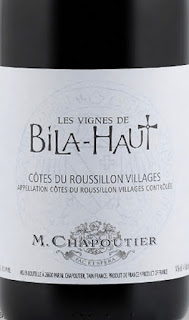The wine we had when my friend, Keith, and I were tasting last week was a Bila-Haut from M. Chapoutier. I'll get into the tasting in a moment but one thing you'll notice is that there is Braille on the label. In fact, most, if not all, of M. Chapoutier's wines have Braille on the bottle. Why is that?
Well, according to Vinepair, when Michel Chapoutier was a young man of 29 years old, and had been in the family wine business for a mere three years, he was watching his friend, musician Gilbert Montagnin, on TV. Gilbert is blind and was explaining how difficult it was for him to identify wines. In fact, he had stopped going to wine shops by himself because he felt so uncomfortable and would only venture in to buy a bottle when with a friend.
Michel knew his friend loved Côtes-du-Rhône wines so he investigated to see how difficult it would be to print Braille on his family's wines labels. As it turned out, it wasn't difficult at all and, from then on, Braille was included on all of the Côtes-du-Rhône wines as well as others that M. Chapoutier makes including Languedoc Rousillon.
And now, several other wine makers include Braille on their labels as well.
For our tasting, we decided to do one of my favourite inexpensive wines, a Bila Haut from Cotes-du-Roussillon Villages ($16.99). At my liquor store there was both a 2017 and 2018 Bila-Haut but Keith could only find a 2018 so that is what we went with. The mix of this wine is Syrah, Grenache and Carignan.
Here are my tasting notes:
Appearance - Clear, deep, ruby.
Nose - Clean, medium intensity, grape, blueberry, plum, blackberry, cranberry, black currant, leather, cloves.
Palate - Dry, medium acidity, medium tannins, high alcohol, medium plus intensity, medium plus body, with flavours of grape, blueberry, blackberry, plum, black currant, tobacco, leather, black pepper,
Evaluation - This was an enjoyable wine on its own but really was a nice food wine (as many wines are). You could drink this now or age for a couple of years. It was balanced, had a good long finish, had pretty good intensity and some complexity. I rated this wine as between Good and Very Good.
This week we tasted another wine from France, a wine from Cahors.
Cahors is in the southwest of France, north of Toulouse. Wine has been made there since Roman times - although one Emperor (Domitian) had all of the vineyards burned in 92 AD because the growers in Italy thought there was too much competition. Happily, by 276 AD, grapes were allowed to grow again and started to thrive as the Roman Empire declined.
In 1152, Cahors wine got a huge boost as it was served at the wedding of Eleanor Aquitaine and Henri Plantagenet, future king of England. It was called the 'black wine of Lot' due to its rich colour and become a hit with wine drinkers in both France and England right up until the late 1800s.
Then that nasty bug phylloxera hit.
After recovering, thanks to American rootstocks, Cahors was hit again in 1956 by massive frosts that wiped out most of the vineyards.
But that wasn't such a bad thing.
After phylloxera, winegrowers ended up planting a variety of different grapes and didn't plant so much Malbec so their wine wasn't that special. After the frosts, however, Malbec (along with some Merlot and Tannat) was the grape planted once again - and 'black wine' was back!
My friend, Keith, is a big fan of Cahors so I was interested in tasting this wine.
We had a 2015 Cahors Château Eugenie Tradition Malbec Merlot ($23.99 - the least expensive Cahors in the liquor store) which was, of course, a Malbec (80%) and Merlot (20%) blend.
Appearance - Clear, deep, ruby.
Nose - Clean, medium plus intensity, black cherry, raspberry, cranberry, blackberry, raisins, pepper, cedar, toast, smoke, leather and tobacco. Developing.
Palate - Dry, high acidity, medium tannins, medium alcohol, medium body, cherry, tobacco, cedar, blackberry, leather, smoke, pepper, tar.
Evaluation - This was another wine that was very enjoyable to drink on its own but was stellar with food (and I am just taking cheese and crackers!). I would drink this now or age for a couple of years (although the producers web site says 3 - 5 years). This was fairly balanced but had a long finish, was intense and was complex. A Very Good wine.
Story time's over.....
Cheers!







No comments:
Post a Comment